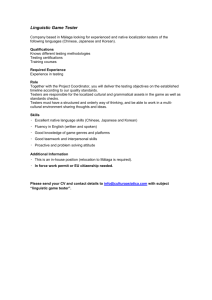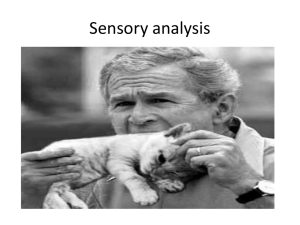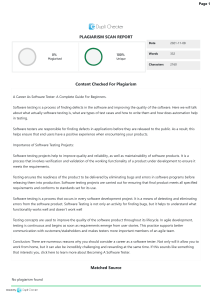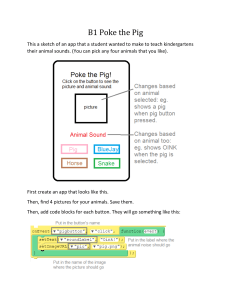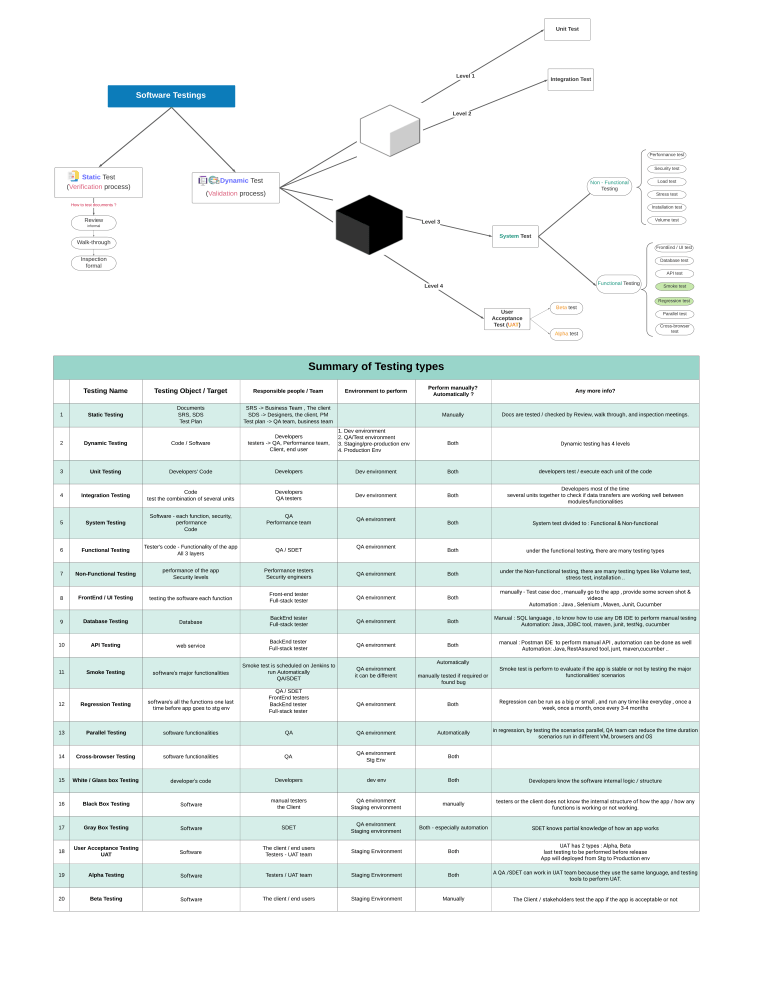
Unit Test Level 1 Integration Test Software Testings Level 2 Performance test Security test Static Test (Verification process) Dynamic Test Load test Non - Functional Testing (Validation process) Stress test How to test documents ? Installation test Review Volume test Level 3 informal System Test Walk-through FrontEnd / UI test Inspection formal Database test API test Functional Testing Level 4 Smoke test Regression test User Acceptance Test (UAT) Beta test Parallel test Alpha test Cross-browser test Summary of Testing types 1 Testing Name Testing Object / Target Responsible people / Team Static Testing Documents SRS, SDS Test Plan SRS -> Business Team , The client SDS -> Designers, the client, PM Test plan -> QA team, business team 2 Dynamic Testing Code / Software Developers testers -> QA, Performance team, Client, end user 3 Unit Testing Developers' Code Developers 4 5 6 7 8 1. Dev environment 2. QA/Test environment 3. Staging/pre-production env 4. Production Env Dev environment Any more info? Manually Docs are tested / checked by Review, walk through, and inspection meetings. Both Dynamic testing has 4 levels Both developers test / execute each unit of the code Both Developers most of the time several units together to check if data transfers are working well between modules/functionalities Both System test divided to : Functional & Non-functional Both under the functional testing, there are many testing types Both under the Non-functional testing, there are many testing types like Volume test, stress test, installation .. Both manually - Test case doc , manually go to the app , provide some screen shot & videos Automation : Java , Selenium , Maven, Junit, Cucumber Integration Testing Code test the combination of several units Developers QA testers Dev environment System Testing Software - each function, security, performance Code QA Performance team QA environment Functional Testing Tester's code - Functionality of the app All 3 layers QA / SDET Non-Functional Testing performance of the app Security levels Performance testers Security engineers testing the software each function Front-end tester Full-stack tester Database BackEnd tester Full-stack tester QA environment Both Manual : SQL language , to know how to use any DB IDE to perform manual testing Automation: Java, JDBC tool, maven, junit, testNg, cucumber web service BackEnd tester Full-stack tester QA environment Both manual : Postman IDE to perform manual API , automation can be done as well Automation: Java, RestAssured tool, junt, maven,cucumber .. software's major functionalities Smoke test is scheduled on Jenkins to run Automatically QA/SDET FrontEnd / UI Testing 9 Database Testing 10 API Testing 11 Environment to perform Perform manually? Automatically ? Smoke Testing 12 Regression Testing software's all the functions one last time before app goes to stg env 13 Parallel Testing software functionalities QA / SDET FrontEnd testers BackEnd tester Full-stack tester QA environment QA environment QA environment Automatically QA environment it can be different manually tested if required or found bug Smoke test is perform to evaluate if the app is stable or not by testing the major functionalities' scenarios QA environment Both Regression can be run as a big or small , and run any time like everyday , once a week, once a month, once every 3-4 months QA QA environment Automatically in regression, by testing the scenarios parallel, QA team can reduce the time duration scenarios run in different VM, browsers and OS Both 14 Cross-browser Testing software functionalities QA QA environment Stg Env 15 White / Glass box Testing developer's code Developers dev env Both Developers know the software internal logic / structure Software manual testers the Client QA environment Staging environment manually testers or the client does not know the internal structure of how the app / how any functions is working or not working. Software SDET QA environment Staging environment Both - especially automation SDET knows partial knowledge of how an app works Staging Environment Both UAT has 2 types : Alpha, Beta last testing to be performed before release App will deployed from Stg to Production env 16 Black Box Testing 17 Gray Box Testing 18 User Acceptance Testing UAT Software The client / end users Testers - UAT team 19 Alpha Testing Software Testers / UAT team Staging Environment Both A QA / SDET can work in UAT team because they use the same language, and testing tools to perform UAT. 20 Beta Testing Software The client / end users Staging Environment Manually The Client / stakeholders test the app if the app is acceptable or not
